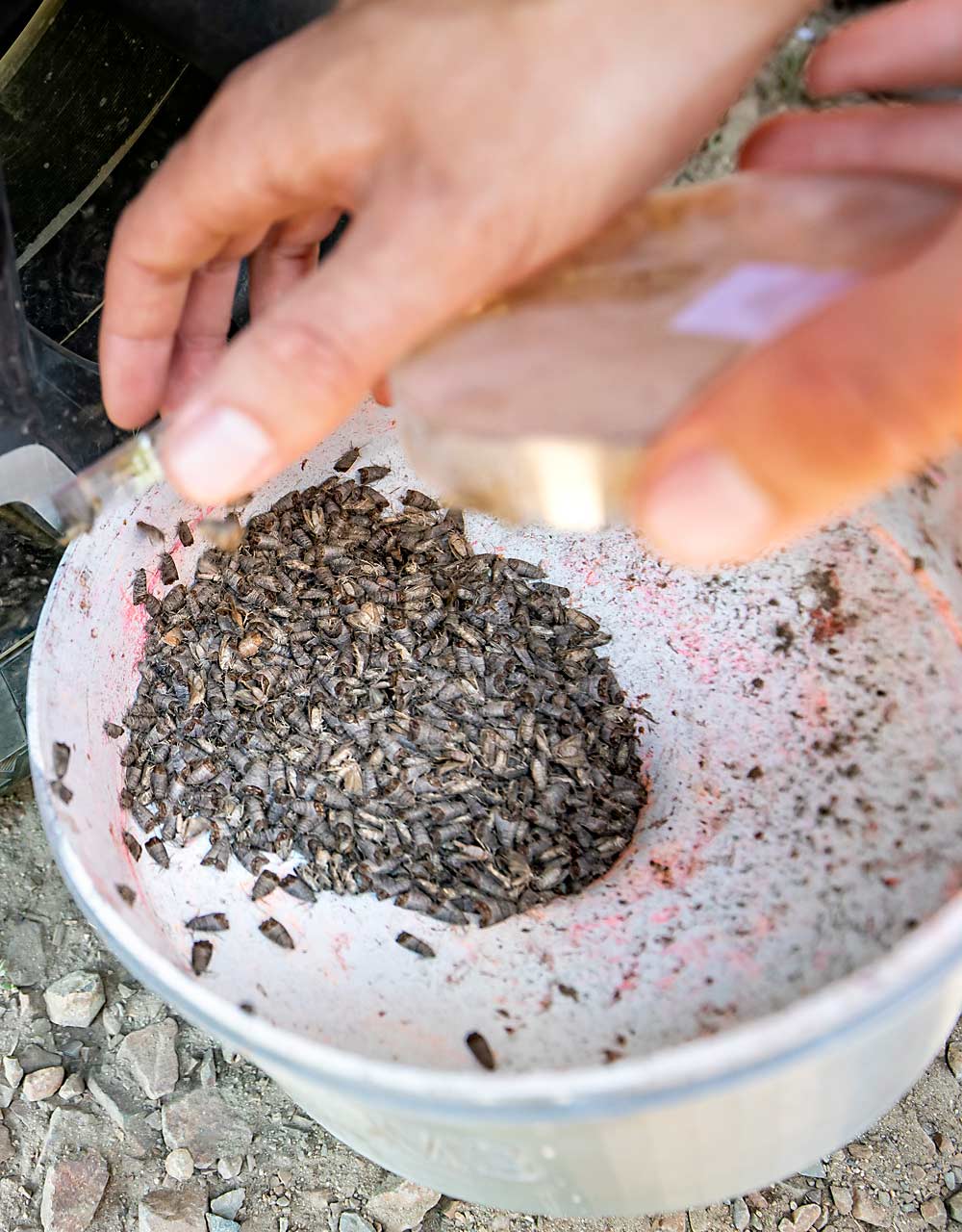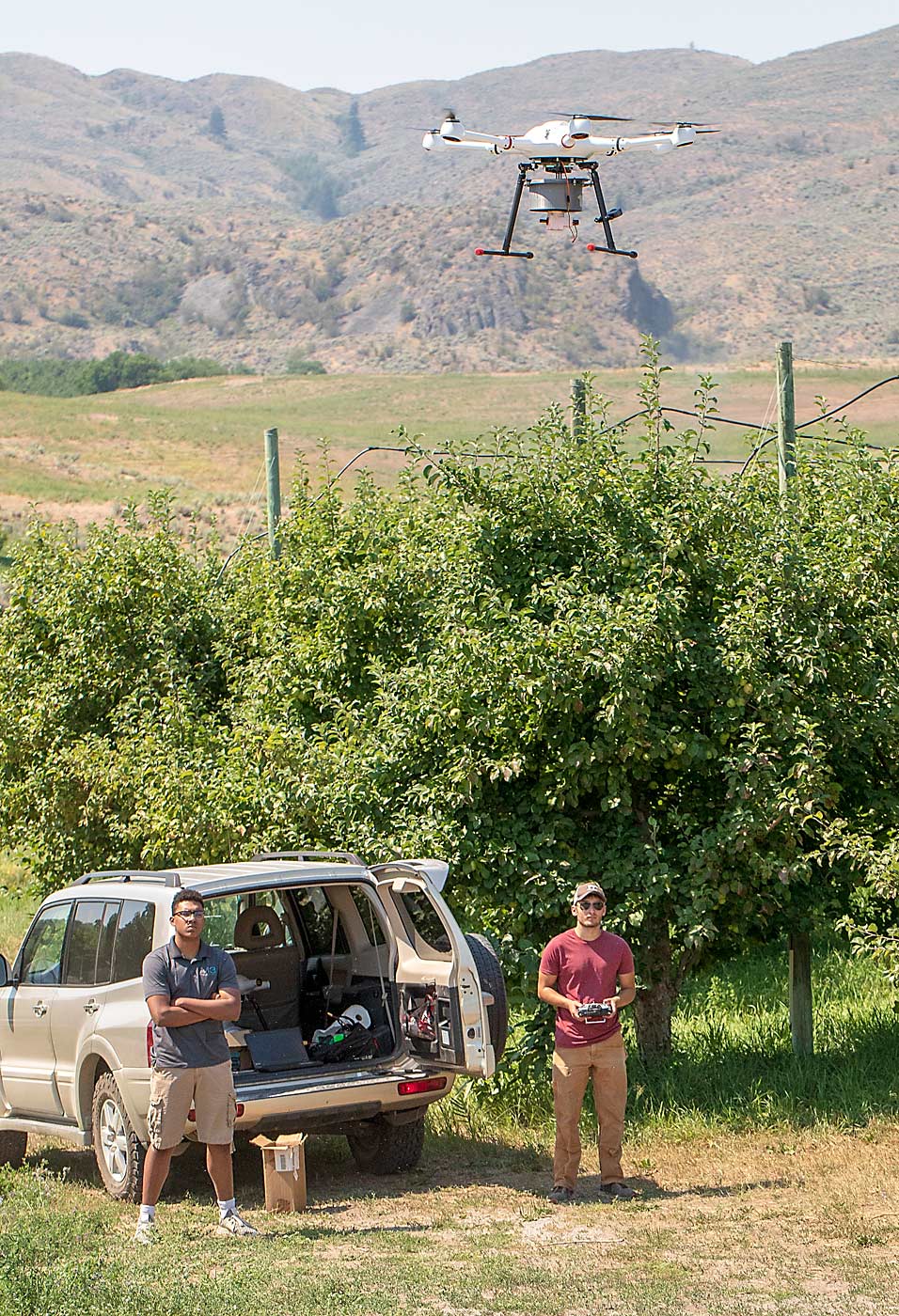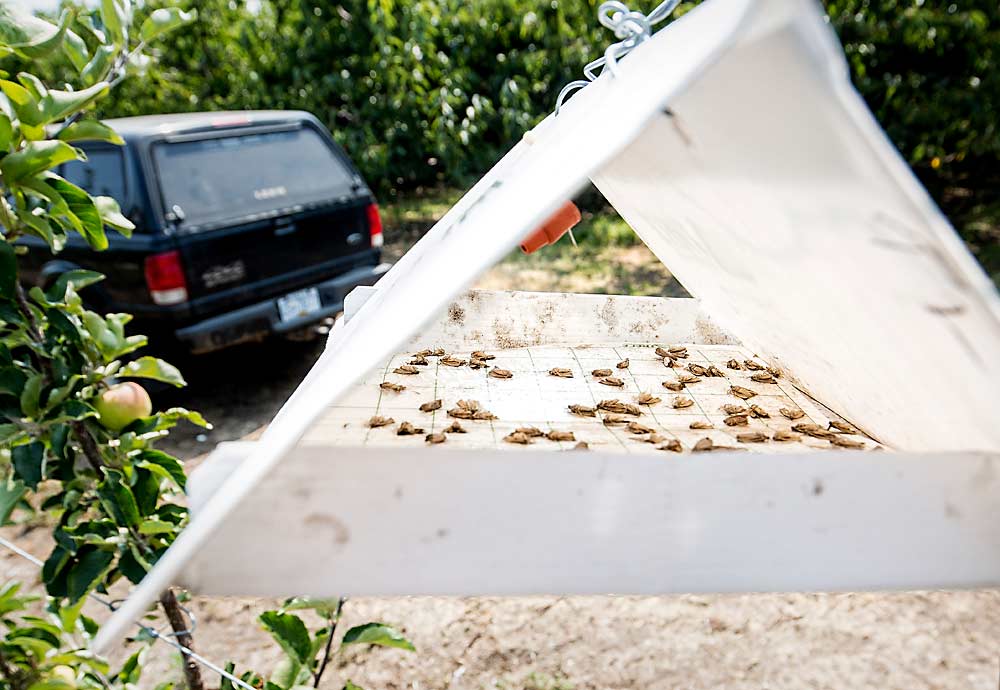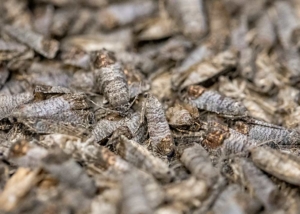Security was tight on the U.S.-Canada border for the passengers in the backseat of the gray Mitsubishi Montero. Uniformed agents pored over their paperwork and opened the minifridge to count the Petri dishes in which the codling moths rode: These moths were travelling internationally and packing some high-level clearances.
“They’re sterilized insects,” said Nathan Moses-Gonzales, an executive partner with the Phoenix-based technology company, M3 Consulting Group, with a laugh. “We know they’re not going to cause any damages or anything, but it’s just the nature of the beast.”
Each week throughout the 2018 apple growing season, Moses-Gonzales and his colleagues drove across the border near Oroville, Washington, to pick up a load of sterilized codling moths from an Osoyoos, British Columbia, rearing facility and haul them back across the border to Washington orchards, in the name of entomology research.

They will add commercial releases this year, using unmanned aircraft to rain down irradiated moths as a way to control the population of their wild cousins. Meanwhile, researchers continue to test the practicality of implementing an entrenched Canadian form of pest control in an American economic environment.
“It’s taking an old technology and turning it around and thinking about it in an entirely new way,” said Betsy Beers, a Washington State University entomologist and principal investigator of one of two research projects involving the use of sterilized codling moths in America.
History
Using sterilized insects to control wild insects is not new. The idea, dating back to the 1930s, is that sterilized bugs mate with the wild population, which then lay eggs that won’t hatch. Eventually, the population crashes.
In the 1950s and 1960s, sterile insect release worked to eradicate the screw worm, a cattle pest, in Florida, Texas and locations throughout the world. Since then, the method has worked with varying degrees of success against some species of fruit flies and mosquitoes. In October, the U.S. Department of Agriculture announced that sterile release and quarantines had eradicated the pink bollworm from the nation’s cotton industry, after 100 years of infestation.

In the 1960s and 1970s, researchers from British Columbia and Washington researched the technique for one of the Pacific Northwest’s most feared apple pests: the codling moth. Their paths diverged in the 1980s when Washington leaned heavily on pheromone mating disruption while the Canadian federal and provincial governments built a rearing facility. The tax-financed program began releases of moths sterilized with radiation, achieving impressive suppression results but not eradication, which was the original goal.
However, in Canada, everybody is in. Sterile insect release is a legislative mandate for apple and pear growers, as well as homeowners. “Growers can’t turn down the insects,” said Scott Arthur, the manager of the Okanagan-Kootenay Sterile Insect Release Program rearing facility in Osoyoos.
Beers, a fellow entomologist, and M3 are exploring sterile insect release in a more … well, American way. Would the method work, they ask, on a voluntary basis as an IPM tool?
Research projects
Beers ran trials from April through September in 2018, in organic blocks throughout Okanogan County, the growing region of Washington adjacent to the Canadian border. She even created a video montage of M3 staff releasing the moths, set to the music of Richard Wagner’s “Ride of the Valkyries,” seasoning her winter presentations with a bit of entertainment value.
Beers measured results by trapping moths and counting signs of fruit damage. Typically, the sterilized populations outnumbered the wild populations, especially in midsummer as the second and third generation emerged, and moth damage was significantly lower in the treated blocks.
The results surpassed her first-year expectations, but the verdict is still out on plenty of details, including how far the moths “drift” outside the target blocks, how they congregate within the blocks and optimal release rates.

Beers’ three-year project was funded by the Washington Tree Fruit Research Commission for $300,000, while she and colleagues from the USDA’s Wapato laboratory seek additional funds from the Western IPM Center.
Rob Curtiss, a Michigan State University Ph.D. candidate, is running a sister research project, studying details such as lower release rates, different release patterns and the effect of trellises and different forms of orchard architecture.
“We’re looking for all the different factors we can change,” he said.
Curtiss plans to compare the M3 drone releases with hand releases, working with about 12 growers in Washington and six in Michigan. Up until this year, the Canadian facility and M3 had been shipping sterilized moths to Michigan for hand release only.
MSU and WSU had been releasing sterilized moths since 2009, as a surrogate, to study the movements of their wild counterparts, Curtiss said. However, they noticed the wild population counts dropping in the MSU research blocks and have shifted to study sterile insect release as a control method for orchard hot spots. Curtiss is continuing that work.
At press time, for his two-year, two-state project, Curtiss was seeking roughly $655,000 from the Washington Tree Fruit Research Commission, Michigan Apple Committee, Michigan State University’s Project GREEEN, Michigan Tree Fruit Research Commission and federal grants.
Though he studies in an MSU program, Curtiss lives in Wenatchee, Washington, and also works part-time as a special projects coordinator for the Washington Tree Fruit Research Commission.
What’s next
Some North Central Washington growers collaborating with Beers like what they see so far and favor continuing it commercially — at the right price.
“We were very pleased, and we hope to participate in the program,” said Jerry Hendrick, a Tonasket orchard manager. He would sign up now but will wait for the research to finish.
Allen Godwin, an organic Tonasket grower working with Beers, favors the whole philosophy of the sterile insect release as another “soft” tool in his IPM belt. M3’s $310 per acre per year price tag sounds high, he said, but he spends about $100 per acre for just one application of Entrust (organic spinosad), an organic insecticide used for codling moth. He budgets between $1,000 and $2,000 per acre each season for chemicals; codling moth chews up nearly half.
However, like many growers, they worry about spending money on pest control if neighbors don’t. Both are at least open to the idea of an areawide approach, especially if the economies of scale reduce the cost per acre.
“The bigger the better, as far as area,” Godwin said.

The researchers are focusing small-scale but aren’t ruling out an areawide approach, either; other large-scale sterile insect success stories exist in America. However, the relative size of the U.S. tree fruit industry — especially Washington’s — would require expensive rearing facilities and assessments to fund operating costs over vast acreage.
“Implementing SIR on a modular, on-demand scale is much more feasible in the short run,” Beers said.
No one is giving up on pheromone disruption, either. It’s the industry’s standard practice but is most effective with low densities, so growers are asking for supplemental tools, Beers said.
In Canada, agricultural officials also are starting to implement pheromone work on their side of the border, as both sides seek more methods of control, said Melissa Tesche, general manager of the Sterile Insect Release Program.
“It doesn’t have to be either or,” she said.
M3 plans to continue releasing moths for the researchers but also make 20 weekly commercial releases over 1,200 acres, Moses-Gonzales said, later scaling up to 5,000 acres, about the limit of the Osoyoos facility’s capacity. In Michigan, the company will work with the researchers using drones this year, hoping to commercialize their work in subsequent seasons.
Moses-Gonzales envisions voluntary programs, too, but he’s thinking big. He and his colleagues have been talking to investors about building a facility similar to that in Canada, figuring the technology is mature enough for the private market to convince an abundance of growers to adopt. He’s been through that difficult “buy-in” process once before. Prior to starting M3, the University of Arizona graduate worked at the USDA’s pink bollworm rearing facility in Phoenix.
“We’re hoping to move fast on this,” Moses-Gonzales said. •
—by Ross Courtney







Darius Moses-Howard & Dustin Crompetz, (Dustin is a personal friend form the Nat. Guard) are really putting this cutting edge tech to a great use, taking the sting out of destructive insects without poisonous chemicals, Great job Dustin! I would like to do this type of work for the chance to invent new methods to improve how we do things. – Marco Cuenca.